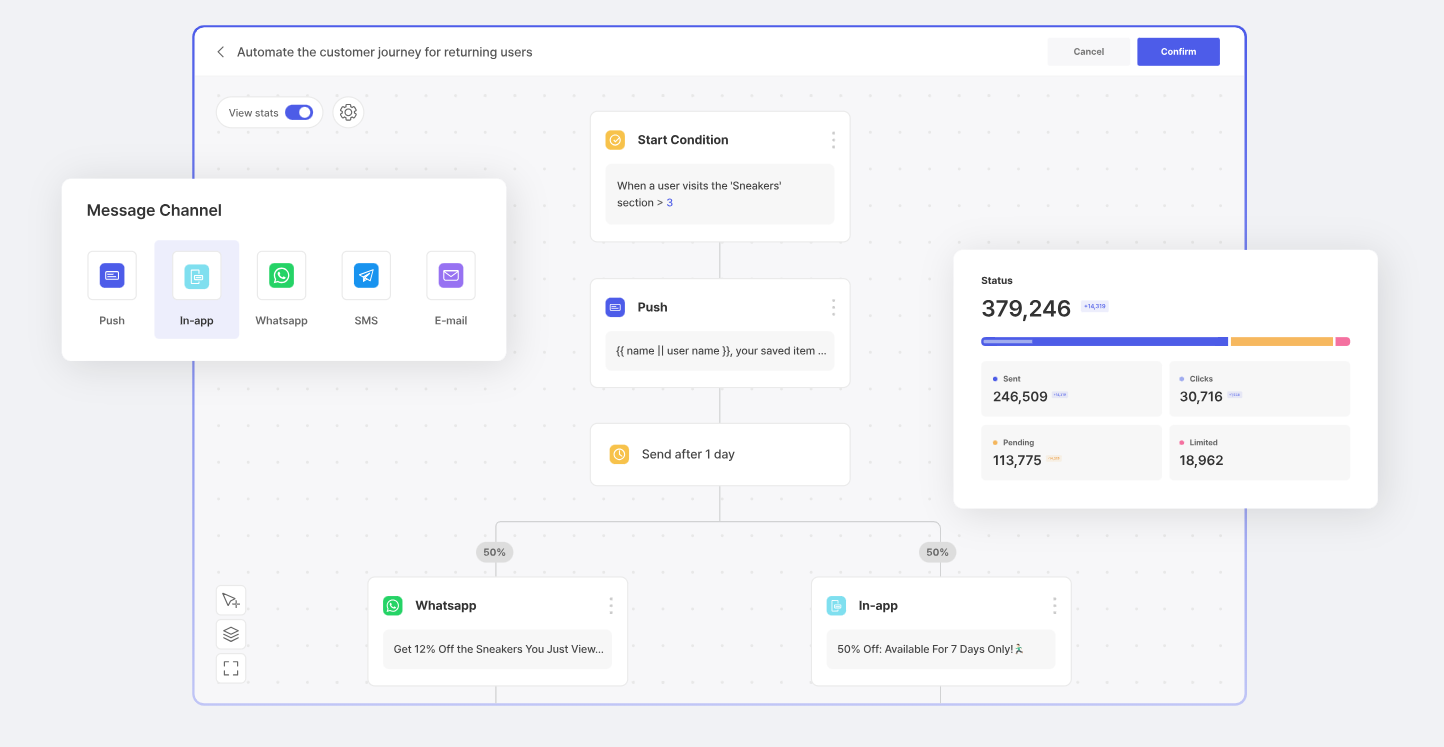5 Benefits of Using CRM Marketing Software Tools for Cross-Channel Campaigns

Modern customers don’t stick to a single channel — one moment they’re checking email, the next they’re on a mobile app or social media. For marketers, this presents a challenge: how do you deliver a cohesive campaign experience across email, SMS, push notifications, and more? Juggling separate tools for each channel often leads to fragmented messaging and a disjointed customer experience.
This is where CRM marketing software for cross-channel campaigns comes in. By centralizing customer data and campaign workflows, these platforms help marketers coordinate outreach on every channel in a seamless way. In fact, companies that excel at cross-channel customer engagement retain on average 89% of their customers, compared to just 33% for those with weak engagement.
In today's article, we'll explore five key benefits of using a CRM marketing software tool for your cross-channel campaigns.
✅A centralized CRM marketing platform breaks down data silos, giving you a single source of truth for each customer. This unified view enables consistent, personalized messaging across all channels, leading to better engagement and loyalty.
✅Advanced segmentation and journey automation tools help deliver the right message to the right audience at the right time. Marketers can easily design multi-channel customer journeys (via email, push, SMS, etc.) that boost conversion and customer satisfaction.
✅Using one platform for cross-channel campaigns streamlines your workflow and analytics. Real-time insights across channels allow optimization, and studies show integrated campaigns drive significantly higher retention and conversion rates than single-channel efforts.
Benefit 1: Centralized Customer Data and a Unified View

One of the greatest advantages of a cross-channel CRM platform is having all your customer data and campaign management in one place. Instead of customer information being scattered across an email tool, an SMS gateway, and an app platform, a CRM marketing system consolidates these into a single customer profile.
This “single source of truth” means every team and channel is working with the same up-to-date data – from purchase history and website behavior to mobile app usage and support interactions. The result is a unified customer view that powers more consistent and relevant messaging on every channel.
When your data is centralized, you can ensure that your marketing communicates a cohesive story. For example, if a customer has already responded to a promotion on one channel, the platform can automatically adjust or suppress messages on other channels to avoid redundancy.
This not only prevents the dreaded scenario of sending conflicting messages, but also opens the door to true personalization. In fact, reports show that marketers who integrate their data sources into unified platforms see dramatic improvements – up to a 166% increase in conversion rates thanks to more personalized, AI-driven content. In short, a CRM marketing tool that ties together data from all touchpoints provides the foundation for everything else: better segmentation, smarter targeting, and consistent cross-channel experiences that delight customers.
Benefit 2: Advanced Segmentation for Targeted Campaigns
Example of segmentation using customer journey (video: FlareLane)
A powerful benefit of CRM marketing software is the ability to segment your audience with advanced filters and criteria. Rather than sending one-size-fits-all blasts, you can group customers based on demographics, behavior, purchase history, engagement level, and more. For instance, you might create segments for “frequent buyers,” “cart abandoners,” or “inactive users,” and then craft specific campaign messages for each group.
This level of granularity ensures that each customer receives content that is highly relevant to their interests or stage in the customer journey. By leveraging these advanced segmentation tools, marketers can deliver personalized offers to each cohort – boosting the chances that the message resonates and prompts action.
The real-world impact of segmentation is significant. Targeted campaigns consistently outperform generic ones in engagement and conversion metrics. According to industry data, segmented campaigns can yield 34% higher open rates and about 26% more orders compared to non-segmented campaigns. This makes sense: when you speak directly to a user’s needs or behaviors, they’re more likely to respond.

Modern CRM marketing platforms often provide intuitive segmentation builders that allow combining multiple conditions (using AND/OR logic) to refine your groups. This means you can get very specific – for example, targeting Android users who opened the app in the last week but haven’t made a purchase – all with just a few clicks. By using advanced segmentation, marketers can maximize the relevance of each touchpoint, leading to higher engagement, improved customer satisfaction, and ultimately greater campaign ROI.
Benefit 3: Seamless Cross-Channel Orchestration with Visual Customer Journeys

Crafting a coordinated experience across multiple channels can be complex – but CRM marketing tools simplify this through visual journey orchestration. Instead of manually managing separate campaigns on email, then push, then SMS, you can design an automated customer journey that ties all these steps together.
For example, using a visual journey builder, a marketer can create a flow: when a user signs up, send a welcome email; if they don’t open the email in 2 days, follow up with an SMS; if they engage, send a push notification with a special offer, and so on. All of these steps are laid out on a drag-and-drop canvas, making it easy to see and control the entire cross-channel campaign logic. Flows can branch based on customer behavior (opened email vs. ignored it), ensuring that each customer’s path is personalized and timely.
The benefit of a visual journey tool is two-fold: it ensures a seamless experience for customers and makes the marketer’s job much easier. Customers are guided through a coherent sequence regardless of channel, which builds trust and keeps them engaged. Meanwhile, marketers can launch sophisticated multi-step campaigns without needing to hard-code triggers or constantly monitor each channel.
Platforms like FlareLane even come with industry-optimized journey templates (for onboarding, cart recovery, re-engagement, etc.) to help you get started quickly. You can customize these or build your own from scratch, using an intuitive interface to add messages, delays, A/B tests, and decision points. Importantly, the journey orchestration runs automatically once activated – saving you time on execution while ensuring no customer falls through the cracks. By automating cross-channel journeys, marketers can focus more on strategy and creative content, confident that the platform will handle the delivery of the right message at the right time on the best channel.
Benefit 4: Multi-Channel Reach with Native Push, SMS, Email, and More
Today’s consumers interact via numerous channels – email, SMS, mobile push notifications, in-app messages, social media, web chat, and beyond. If your marketing tools aren’t integrated, keeping up with these interactions can become a nightmare. CRM marketing software with native multi-channel support eliminates this headache by bringing all key channels under one roof.
You can compose and send an email, craft a push notification, queue up an SMS, or even trigger a webhook to another service, all within the same platform interface. This unified approach means your cross-channel campaigns truly fire on all cylinders: customers receive a cohesive message whether they see it in their inbox, on their phone lock screen, or inside your app.

The ability to orchestrate different channels in unison greatly expands your reach and effectiveness. You’ll engage customers on their preferred channel without missing those who might ignore others. For example, you might use email for detailed content but follow up with a short SMS for urgency, or use push notifications to draw users into your app and then show an in-app message with more details. Because it’s all managed together, the messaging stays consistent and the timing can be synchronized.
Marketers no longer have to log into five different tools or coordinate across siloed systems — saving time and reducing errors. Moreover, the payoff for true cross-channel marketing is proven: companies with strong omnichannel engagement strategies retain 89% of their customers on average, versus only 33% for companies with weak engagement.
In practice, this means an integrated platform can dramatically improve customer loyalty and lifetime value by ensuring your audience is continuously and contextually engaged, wherever they are. By leveraging native support for channels like email, SMS, push, in-app, and webhooks to connect additional touchpoints, a CRM marketing tool allows your campaign to meet the customer anywhere – and do so in a coordinated, efficient manner that single-channel tools can’t match.
Benefit 5: Real-Time Analytics and Improved Campaign ROI
Running cross-channel campaigns on a centralized CRM platform also gives you the advantage of consolidated, real-time analytics. Instead of piecing together reports from separate email, SMS, and push systems, you’ll have a single dashboard showing how your campaign is performing across all channels. This holistic view is critical for understanding the customer journey and campaign effectiveness. You can see, for instance, that a user clicked an email, then later responded to a push notification, and ultimately made a purchase — all attributed within one funnel. With such insights, marketers can pinpoint which channel combinations and sequences are driving conversions or where drop-offs occur.
Access to real-time performance data means you can optimize on the fly. If you notice that the SMS step of your journey has a significantly higher conversion rate than the email, you might decide to emphasize SMS or refine your email content. Metrics like open rates, click-through rates, and conversion rates for each channel are tracked automatically, empowering you to continuously improve your strategy. Over time, this data-driven refinement leads to better outcomes and higher return on investment (ROI) for your campaigns.
Marketers using an integrated platform have reported substantially higher engagement and purchase rates – one study noted that campaigns running on three or more channels achieved 250% higher purchase rates than those using a single channel. Furthermore, a centralized tool improves team efficiency: automation features handle the repetitive tasks (such as sending follow-up messages or tagging customers based on behavior) and free up your team to focus on creative strategy and analysis. Instead of wasting hours reconciling data from different sources, marketers can spend time acting on insights. In summary, a CRM marketing software not only streamlines your analytics but also amplifies your results – helping you get more bang for your marketing buck through smarter allocation of resources and continuous optimization.
Final Thoughts
Cross-channel campaigns are no longer a luxury in modern marketing – they’re a necessity. Customers expect brands to recognize them and communicate consistently whether they’re on a website, an app, or their SMS inbox. Using a CRM marketing software tool makes delivering this cohesive experience far easier and more effective. From a unified customer view and finely targeted segmentation to automated journeys and integrated multi-channel delivery, the benefits are transformative. Marketers can build more engaging campaigns, respond to customer behavior in real time, and ultimately foster stronger relationships that drive revenue.
Platforms like FlareLane exemplify these advantages by providing all the capabilities under one hood. FlareLane offers advanced segmentation, visual customer journey builders, and native support for push notifications, SMS, email, webhooks and more – allowing you to orchestrate customer engagement without the usual technical headaches. The real-world value is clear: you get a centralized hub to plan, execute, and analyze campaigns, which translates to improved efficiency and better campaign ROI.
Want to learn more about CRM marketing strategies and data integration? Explore other articles below!
👉Read more: 5 Benefits of Connecting a Data Warehouse to Your CRM
👉Read more: 5 Proven Strategies to Boost Customer Engagement
👉Read more: 10 Reasons Why Your Push Messages Are Not Delivered


